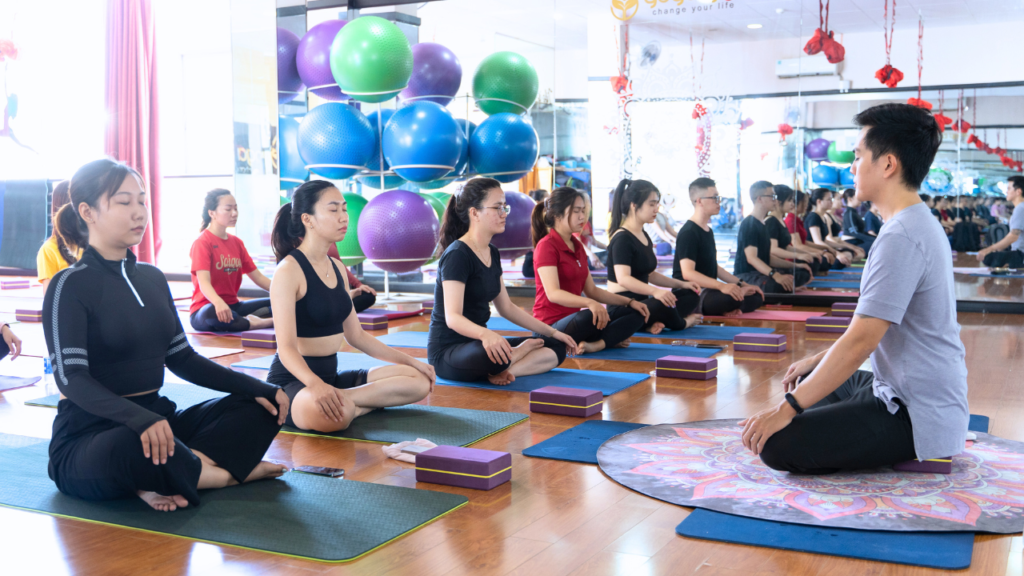In today's competitive yoga market there are countless yoga classes, so making your brand stand out and attract the right customers can be a challenge. However, by applying effective marketing strategies, you can attract potential students, turn them into loyal customers, and grow your yoga business.
In this article, Nguyen will provide you with essential marketing methods to attract customers to your yoga class. Nguyen will share important strategies such as identifying ideal students, building a positioning strategy, leveraging appropriate marketing channels, and nurturing student relationships. By applying these tips, you can build a solid foundation for success and create a thriving yoga business.
1. Identify Your Ideal Yoga Student

Before marketing your Yoga class, you need to identify the right student base for your curriculum. Because each group of people will have different "interests", to address the concerns and potential motivations of your target audience, you must "know" who they are.
Consider some of the following aspects when drafting a student “portrait”:
- Experience: Is your student completely new to yoga? Or do they have some background in practice? Determining the appropriate level of experience is key in effectively tailoring the classroom.
- Target: What are your students looking for in yoga? Do they want to increase flexibility, reduce stress, improve strength, or find a deeper spiritual connection? Understanding student motivation will help you build a class that suits their individual needs.
- Style of life: Does the ideal student integrate yoga into a busy life or are they looking for a comprehensive change? Determining the typical lifestyle of your students will help you shape your class schedule and marketing activities.
- Demographic: Think about the age, gender, and cultural background of the people you want to attract. This understanding assists in creating an inclusive, engaging learning community.
- Character: Are you looking for enthusiastic and extroverted students, or quiet people with introverted tendencies? Understanding your preferred student personality helps you create a compatible classroom atmosphere.
Once the target student group is identified, all marketing and communication messages are aimed at that student group, solving their problems and desires.
2. Building a Positioning Strategy

In the competitive yoga market with many strong brands, it is essential to build a solid positioning strategy to stand out from the competition. This strategy acts like a compass, guiding your business and attracting the right customers. A strong, clear strategy makes your classroom recognizable and engaging. Ask yourself, “What makes my approach to yoga unique?”
Here are some factors you should consider when creating your strategy:
- Unique value: Identify your core values as a yoga instructor. What do you offer that other coaches don't? This could be a unique major, an engaging teaching philosophy, or the ability to create a highly personalized experience.
- Expertise and teaching style: Which style of yoga are you passionate about? Are you particularly good at imparting technical instructions or creating a calming meditative atmosphere? Understanding your strengths is important in attracting students who love that style and expertise.
- Language and communication on the internet: How you articulate your mission, vision, and offerings plays an essential role. Your words should reflect the students you are targeting. Consider using appropriate terminology to appeal to your specific demographic.
- Marketing Channel: Identify the platforms your ideal students frequent. Building a strong online presence on these platforms is important when connecting with your target audience.
After positioning your brand, you will use this positioning consistently, communicating to customers the difference, creating trust, thereby attracting more students to the course.
3. Design Marketing Channels for Yoga Classes

In today's digital world, it's wise to expand your marketing presence across multiple, relevant channels. A diversified approach will help you reach potential students at many different points. Let's explore some of the most effective marketing channels in yoga:
- Social Media: Social platforms like Facebook, Instagram and TikTok play an important role in building brand awareness and connecting with target audiences. Sharing engaging content, updating regularly, and interacting (properly) with the community is the key to marketing success.
- Email Marketing (Email Marketing): Many people mistakenly think that email is spam. But actually building a mailing list is a great way to nurture leads and encourage them to sign up for classes. Use email to share valuable content, information about upcoming promotions, and updates from your business.
- Search engine optimization (SEO): Make sure people looking for Yoga services in your area can easily find you online. Use popular, relevant keywords and optimize your site for local searches.
- Paid advertising: Paid advertising on platforms like Google Ads and Social Media can reach specific audiences in large numbers. This provides high visibility and drives strong growth in your website traffic.
- Cross cooperation with other businesses: Build connections with businesses in your area, such as health food stores, gyms, and spas. Cross-collaboration expands your reach, exposing you to entirely new customers.
- Word of mouth introduction: Create an exceptional learning experience that leaves your students passionate about spreading the word about your services to friends and family. Encourage referrals by offering incentives and rewards. (This is also the marketing method Nguyen applies most often to her Yoga classes)
Remember that yoga marketing (specifically the wellness industry) is an ongoing process, it's important to test strategies, track results, and adjust your approach over time. With effort, you will discover the perfect strategic combination that attracts your ideal customers.
4. Nurture Student Relationships

Long-term success as a yoga instructor depends greatly on your ability to build strong, sincere relationships with your students. Deep student relationships lead to higher levels of retention, positive referrals, and a thriving sense of community. Here are some strategies for cultivating strong bonds with your program participants:
- Create a welcoming environment: Encourage a positive and non-judgmental atmosphere in classrooms. Students need to feel supported and accepted, regardless of their experience level. Be open to questions, feedback, and tailor your class to address unique needs.
- Personalize the experience: Take the time to get to know your students. Remembering students' names, interests, and progress builds trust and shows a genuine level of interest.
- Open communication: Be accessible beyond the classroom. Give students ways to contact you to ask questions. Use channels like email, SMS, or an online community group to stay in touch.
- Organizing social events: Encourage interaction between students outside of class. Hosting events such as workshops, retreats, or community gatherings creates opportunities to bond and build deeper relationships.
- Show appreciation: Don't be afraid to show deep appreciation for your class participants. Handwritten greeting cards or special offers show that you truly appreciate each individual.
Effective yoga class marketing is key to attracting and retaining potential students, fueling the growth of your yoga business. By applying the strategies mentioned in this article, you can build a strong brand, attract the right customers, and create an engaged yoga community.



